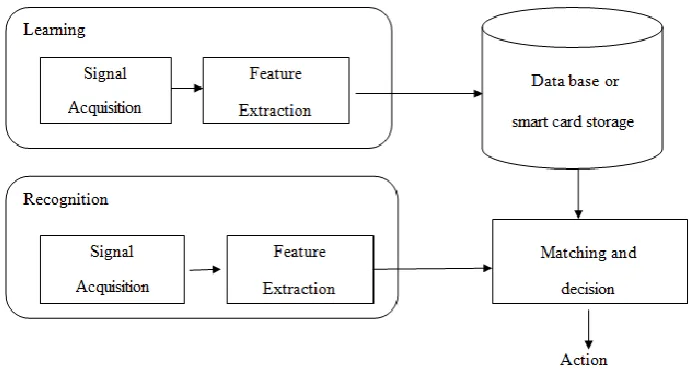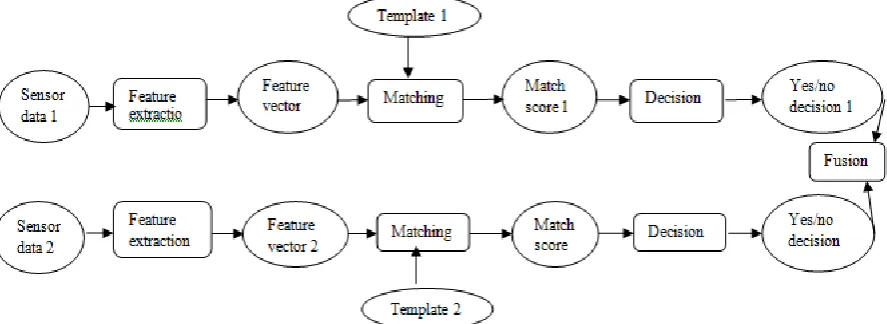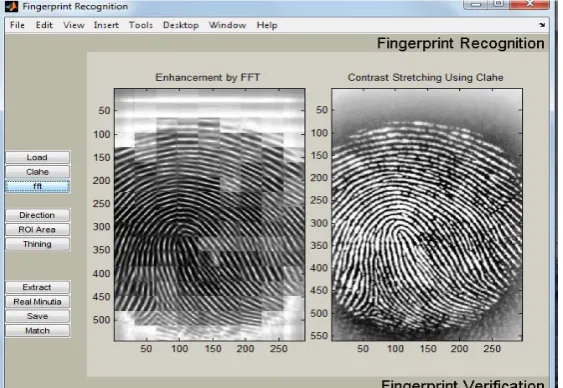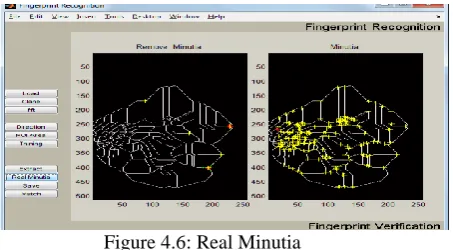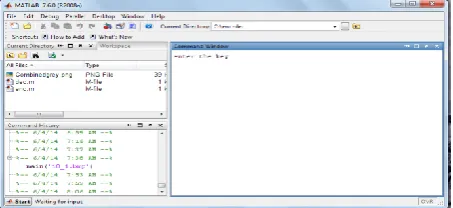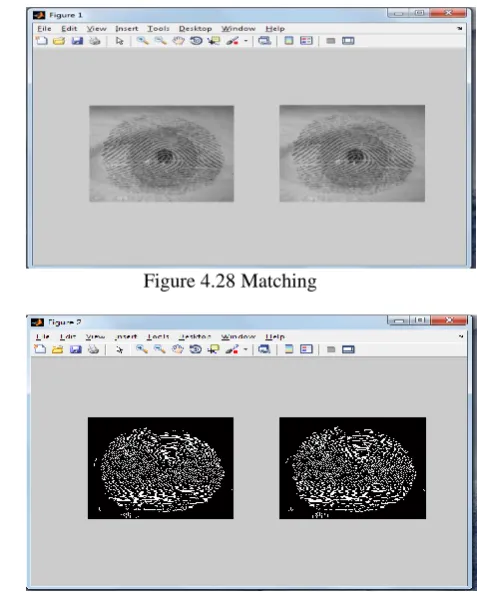An Enhanced Multi-Modal Biometric System for Secure User
Identification
Abstract: A biometric system is a methodological system that uses information about a person to recognize that person. Biometric systems focusing completely on the identification of humans have become the major kind of biometric system in today’s IT word. Biometrics machines have different techniques to do the verification first is the physical verification in which fingerprint recognitions, face recognition, retina recognition etc. have done second one is the behavioral recognition in which voice recognition, signature recognition have done. Unimodal biometrics systems have lots of problem for e.g. noisy sensor data, lack of invariant representation etc. These problems lead to the use of multimodal biometrics. In this paper our objective is to increase the performance of multimodal biometric and to provide security of biometrics template stored in the database and the performance of multimodal biometrics can be increased by extracting the features of fingerprint and iris at feature extraction level and security provided using the method of fused images encryption using AES technique and then matching is done to confirm the encryption also.
Keywords: Biometric system, physical characteristics based techniques, behavioural characteristics based techniques, fingerprint recognition, sensor module feature extraction, sensor module, finger print identification.
I. INTRODUCTION
1.1 Definition of biometric system:
Biometrics is the science of establishing the identity of an individual depend on the physical, chemical or behavioral attributes of the person. Biometric systems are more convenient than traditional authentication techniques since there is no password to be forgotten or smart card to be lost [3].Biometric-based verification systems represent a valid alternative to conventional approaches [1]. In the subscription process, user’s initial biometric sample(s) are collected, assessed, processed, and stored for ongoing use in a biometric system. In verification mode (1:1 matching process) the user claims an identity and the system verifies whether the claimant is accurate or fraud. If the user’s input and the template of the claimed identity have a high degree of similarity, then the claim is accepted as correct. Otherwise, the claim is rejected and the user is considered as “fraud”. In Identification mode (1:N matching process) the user’s input is compared with the templates of all the persons registered in the database and the identity of the person whose template has the highest degree of similarity with the user’s input is the biometric system’s output. If the highest similarity between the input and all the templates is less than a fixed minimum threshold, system rejects the input, which implies that the user presenting the input is not one among the enrolled users [4].
1.2 Category of Biometrics Technique
Biometric techniques can be divided into two categories i.e physical characteristics and behavioral characteristics based methods.
(i) Physical Characteristics Based Techniques
Biometric techniques based on physical characteristics of human being such as hand geometry, fingerprint, palm-print etc. are called physical features based techniques. Following are examples of biometric techniques based on physical features.
• Hand geometry recognition • Face recognition
• Vein pattern recognition • Retina recognition • Iris recognition • Fingerprint recognition
(ii) Behavioural Characteristics Based Techniques Ahmad Tasnim Siddiqui
Research Scholar OPJS University, Churu, Rajasthan, India Email: tasnim5@yahoo.com
Dr. Vaibhav Bansal Associate Professor - CSE
Biometric techniques which are depend on the behavior of human being like as voice, signature, gait, keystroke etc. are called behavioral characteristics based techniques. Following are examples of biometric methods based on behavioral characteristics.
• Voice recognition • Signature recognition • Keystroke dynamics • Gait recognition
1.3 Modules of Biometric System
The biometric system consists of following four modules: • Sensor module
• Feature Extraction • Matcher
• System database
Sensor module: It captures the biometric data of personal. Fingerprint sensor is example of sensor module,it captures the ridge and valley structure of user finger.
Feature extraction: In this module captured biometric data is processed and set of features are extracted.
Matcher module: In this module to produce matching score during recognition, features are compared against the stored templates.
System database module: This module stores the templates of users. It stores the multiple templates of user to account for deviations observed in biometric data & templates in database are updated over time [4].
1.4 Biometric Technologies
1.4.1 Fingerprint Identification
Fingerprint identification is the method of identification using the perception made by the minute ridge formations or patterns found on the fingertips. No two persons have exactly the same compromise of ridge patterns (even identical twins), and the patterns of any one individual remain unchanged throughout life.
1.4.2 Hand Geometry
When measuring hand geometry biometrics, three-dimensional image of the hand is occupy and the shape and length of fingers and knuckles are measured. Hand geometry has been in use for many years in many applications, predominantly for access control. The technology does not achieve the highest levels of accuracy but it is appropriate and fast use. On the capture process a user places a hand on the reader, aligning fingers with especially situated guides. Cameras, positioned on above and on the side of hand capture images from which measurements are taken at selected points.
1.4.3 Face Recognition
Face recognition technologies analyze the unique shape, pattern and positioning of facial attributes. The face is natural biometric because it is a key component in the way we humans recollect and recognize each other. Face recognition is very typical technology and largely software based. Artificial intelligence is used to duplicate human interpretation of faces. The problem with human face is that people do change over time; wrinkles, beard, glasses and location of the head can affect the performance considerably. To increase the accuracy and adjust to these changes some kind of machine learning has to be executed. There are essentially two methods of capture: employ video or thermal imaging. Video is more frequent as standard video cameras can be used. The precise position and angle of the head and neighboring lightning conditions may affect the system’s performance.
1.4.4 Finger Geometry
Finger geometry biometric is very closely linked to hand geometry. The use of just one or two fingers means more concentrated, smaller devices and even higher throughput. Two variations of capture processes are used, first being similar to hand geometry defined above. The second technique requires the user to insert a finger into a burrow so that three-dimensional measurements of the finger can be prepared.
1.4.5 Palm Scanning
1.4.6 Signature
Signature is one of the most accepted methods of asserting ones identity. As we generally use it the signature is scrutinized as a static trace of pen on the paper. In computerize form the static geometry of signature is not adequate to ensure the uniqueness of its author. Signature biometrics often mentioned to dynamic signature verification (DSV) and look at the way we sign our names. Examples of these behavioral features are the angle of the pen is held, the time taken to sign, velocity and speeding up of the tip of the pen, number of times the pen is uplifted from the paper. Signature data can be catched using a special sensitive tablet or pen, or both. On some easier cases equipment found relatively cheap from normal computer stores can be used. This measures the sound that a pen makes versus paper. Because of the behavioral temper of signature, more than one signature register is needed so that the system can build a profile of the signing properties [5].
Figure 1.1: Examples of some of the biometric traits used for validating an individual
1.5 Architecture of a Biometric System
Basically speaking, there are two phases in a biometric system (see Fig 1.2.): a learning phase (enrolment) and a recognition phase (verification). The recognition module permits a decision to be taken. In identification mode, the system relates. The measured signal with the lotsof models occupied in the data base and selects the model most closely related to the signal. And In verification mode, the system will collate the measured signal with just one of the data base models and then sanction the person or refuse him. Identification may be a very difficult task if the data base occupied thousands of individuals. Access time problems then become crucial [6].
Figure 1.2: The various modules of a biometric system
1.5.1 Different Problems with Different Scopes and Challenges
We refer to identify three various ways of using a biometric system:
Biometrics can check with high confidence the authenticity of a requested enrolment based on the input biometric sample. business applications such as computer network login, electronic data safety, ATMs, credit card shopping, physical access control, cellular phones, PDAs, medical records arrangements, and distance learning are sample validation applications.
2. Large Scale Identification (“Check on the existence of the person in database?”)
Mentioned an input biometric sample, a large-scale recognition dictates if the pattern is associated with any of a bulk numbers (e.g., millions) of enrolled identities. Classic large-scale identification applications comprises welfare- payment, national ID cards, border control, driver’s license, criminal investigation, voter ID cards, body identification, parenthood confirmation, missing children recognition etc.
(iii) Screening (“whether a person wanted?”)
Screening applications secretly and unobtrusively decide whether a person belongs to a check-list of identities. Examples of screening applications could consist of airport security, safety at public events, and other surveillance applications. The screening watch list consists of an average (e.g., a few hundred) number of identities.
1.6 Biometric errors
There are two types of errors: Matching errors and image acquisition errors. Multimodal Biometrics:
Unimodal biometric system performs person recognition depend on a single source of biometric information [11]. These systems are often influenced by the following problems:
1. Disordered sensor data 2. Lack of individuality
3. Lack of invariant representation 4. Susceptibility to circumvention 5. Non- universality
Such factors lead to the usage of multimodal biometric for identifying individuals. Combining the evidence obtained from different procedures using an effective fusion scheme can appreciable improve the overall accuracy of the biometric system. A multimodal biometric system can diminish the FTE/FTC rates and provide more resistance against spoofing because it is difficult to concurrently spoof multiple biometric sources [7].
1.7Levels of Multimodal Biometrics
Four possible levels of fusion methods are used for combining data from two are more biometric systems. These are sensor level, matching score level, decision level and feature extraction level. Feature extraction level and Sensor level are called pre-mapping fusion levels and matching score level and decision levels are called post-mapping fusion levels.
Fusion at the sensor level
In this level raw data is acquired from sensing the same biometric features with two or more sensors.
Figure 1.3: Fusion at sensor level
Fusion at matching score level
In this fusion method there are two approaches for consolidating the scores produced from distinct matchers [9]. One of them is to formulate it as a classification problem and the second is as a combination problem. In classification method, a feature vector is designed by using matching scores output of personal matcher and then categorized into two classes: “Accept” and “Reject”.
Fusion at decision level
with weighting for each kind result, ultimate decision is adopted for final result. Thus, fusion at this level is the least powerful result [2].
Figure 1.4: Fusion at matching score level
II. RELATED WORK
The research work performed in this field by different researchers is presented as follows:
Kankrale R.N. et al [1] author aims at combining two biometric features namely iris and fingerprint at decision level using Fuzzy logic. Multimodal biometric identification system to combine two or more physical traits to minimize False Accept Rate (FAR) and FRR (False Reject Rate) in more detail, fuzzy logic based approach at decision level is used for concatenation and every biometric result is weighted for engaged in final decision. Fuzzy logic is used for the effect of each biometric result integration. The proposed multimodal system attains interesting results with several commonly used databases. For example, the author had produced an interesting working point with FAR = 0% and FRR=3.43% using entire CASIA Fingerprint and a unplanned separated same size subset of the CASIA Iris database [13].
Mohamad Abdolahi et al. [2] Single biometric systems have a lots of problems like as noisy data, non-universality, spoof attacks and unacceptable error rate. These restrictions can be resolved by positioned multimodal biometric systems. Multimodal biometric systems utilize two or more individual procedures like face, iris, retina and fingerprint. Multimodal biometric systems improve the identification accuracy more than unimodal methods. The author uses, two unimodal biometrics, iris and fingerprint are used as multi-biometrics and display applying this biometrics has good result with high accuracy. Decision level is used for fusion and every biometric result is weighted for to take part in final decision. Fuzzy logic is used for the effect of each biometric result combination.
N. Radha et al. [3] Authentication of users is an essential and difficult to achieve in all systems. Disclosed secrets like PIN i.e.Personal Identification Numbers or Passwords and key devices such as Smart cards are not presently appropriate in certain situations. The biometric refines the capability to recognize the persons. A biometric identification system is an self-directing recognition system that recognizes a person based on the physiological features (e.g., fingerprints, face, retina, iris, ear) or behavioral features (e.g., gait, signature, voice) characteristics. In many real-world programs, unimodal biometric systems often face has remarkable limitations due to sensitivity to noise, intra class inconstancy, data quality, non-generalization and other factors. Multimodal biometric systems overcome some of these limitations. Multimodal biometric system assigns more accuracy when related to unimodal biometric system. The main goal of multimodal biometric system is to develop the safety system for the areas that require high level of security. The proposed system stressed on expanding a multimodal biometrics system, which uses biometrics such as fingerprint and iris. Fusion of biometrics is accomplished by means of rank level fusion. The features from the biometrics are obtained by using the FLD i.e. Fisher Linear Discriminate. The experimental result shows the performance of the proposed multimodal biometrics system. The decision is build using rank level fusion and the ranks of individual persons are calculated using the Borda count, and Logistic regression approaches.
or more physical or behavioral processes. Multimodal biometric system is used in order to improve the accuracy. Multimodal biometric identification system relies on iris & fingerprint trait is proposed. Typically in a multimodal biometric system each biometric property processes its information independently. The processed information is combined using a suitable fusion scheme [15]. Individually, the correlation of data base template and the input data is done with the help of algorithm Euclidean-distance matching. If the templates are matched the person can access the system. FAR & FRR are also checked with different threshold level. Multimodal biometric system provides ideal False Acceptance Rate (FAR) & False Rejection Rate (FRR), therefore improving system accuracy & reliability.
Rupesh Wagh and Arti P choudhary [5]. The authors concluded that Multimodal biometrics gives accuracy in providing results as contrast to unimodal system. With experimental results it will prove that accuracy of multimodal system is refined than fingerprint and Iris unimodal system. They are using digital image processing with cryptography i.e. two technologies are combined [14].
Taruna Panchal and Ajit Singh [6]. They concluded that the biometric template is much more secure than before as there was just little change in biometric template using parity check method used in watermarking technique. The modified data is encrypted and hence while decryption real data is not exposed which also overcomes encryption disadvantage. It provides good security and is suitable for any large scale data. In future, these techniques can be applied to different attack areas to protect attacking on these areas.
III. PROPOSED WORK
1.1 Problem Formulation
Unimodal biometric system performs person identification based on a single source of biometric statistics. Such systems are often affected by the following problems:
Noisy sensor data Non- universality Lack of individuality
Susceptibility to circumvention Lack of invariant representation
Such factors lead to the usage of multimodal biometric for identifying humans. Combining the evidence obtained from various modalities using an effective fusion scheme can appreciably improve the overall accuracy of the biometric system. Multimodal biometric system can reduce the FTE/FTC rates and provide more resistance versus spoofing because it is difficult to concurrently spoof multiple biometric sources [8].Multimodal biometrics system has lots of advantage as follows [10]:
Its makes better system operations.
Its accuracy is better as contrast to the uni-biometric system.
It prevent from stolen the templates of biometric system as at the time it stock the two characteristics of biometric system in the database.
1.2 Proposed Work
The basic idea behind the problem is to improve the performance and feature extraction of multimodal biometric systems applying various techniques. In the suggested approach, the two biometric templates will fuse ahead matching to generate multimodal biometric template. The template saved in the database is not secure as a number of attacks are possible like modification of template etc. In order to provide database safety different encryption technique will be used to generate secure template.
IV. RESULTS AND ANALYSIS
4.1 Planning of work
Our main focus is to enhance the technique of feature extraction of both the characteristics. This enhancement is done through feature level extraction and fusion is done through fuzzy logic. Then the fused vector is encrypted using different security technology.
Step 1: Fingerprint and Iris biometric sample will be recorded using different sensors. Step 2: Features will be extracted differently from both the biometrics.
Step 4: Generated template will be stored in the database.
Step 5: Above stored template will be protected through Cancellable Biometric. Step 6: Security will forby increase by encrypting the template using cryptography.
4.2 Tool Used
4.2.1 MATLAB
MATLAB (matrix laboratory) is a multi-paradigm numerical computing environment, a high-level language and interactive environment, and fourth-generation programming language for numerical computation, visualization, and programming. MATLAB provides built-in 2-D and 3-D plotting functions, as well as volume visualization functions. You can automatically produce a report when you execute a MATLAB program. The report contains your code, comments, and program results containing plots. Reports can be published in a variety of formats, such as HTML, PDF, Word, or Latex.
4.2.2 Fuzzy logic
These are used for the fusion of two feature extracted templates. Fuzzy logic enables us to process the information in a same way like human thinking, i.e. big against small or high against low. It makes intermediate values to be explained between true and false by partial set memberships [12].
4.3 Methodology
4.3.1 Fingerprint Recognition
A fingerprint is collection of ridges and furrows which are parallel and have same width [2].
4.3.2 Iris recognition
Iris is a circular diaphragm which is placed between cornea and lens of the human eye. The function of iris is to control the amount of light entering through the pupil.
4.4 Steps for fingerprint recognition:
The fingerprint samples are saved in a folder for feature extraction and the feature extraction is done in the fingerprint recognition systems. Following are some figures.
4.4.1 Load Click the Load button to load the fingerprint sample in the Fingerprint recognition system. 4.4.2 CLAHE Click on the CLAHE to get the Contrast Stretching.
4.4.3 FFT Enter any FFT value between 0 and 1 and then we get the enhanced image according to that value
4.1.4 Direction
Figure 4.2: Direction 4.1.5 ROI Area
Figure 4.3: Region of Interest 4.1.6 Thinning
Figure 4.4: Thinned-ridge map 4.1.7 Extract
Figure 4.5: Extract
4.1.8 Real Minutia By clicking real minutia we will get the real image of the minutia to which we have to match the fingerprint.
Figure 4.6: Real Minutia
4.1.9 Save Click on the save button to save the
extracted image.
Figure 4.7: Saving the extracted image
4.1.10 Match the saved image and the previous
image is then matched to get the 100% result. Here we will find whether the person is genuine or fraud.
Figure 4.8: Match score
4.2 Steps for iris recognition
The overall process for acquiring and storing iris features with iris images can be given as follow:
Figure 4.9: Iris sample images
4.2.2 Write down the command in command
window in MATLAB to get the segmented image of iris
Figure 4.10: MATLAB command window
4.2.3 All the images will be stored in the diagnostic folder as shown below.
Figure 4.11 Diagnostics folder
We will get the following images in the folder
Bmp-normal
Figure 4.12: bmp-normal
Noise
Figure 4.13: Noise
Polar
Figure 4.14: Polar Polar noise
Figure 4.15: Polar Noise
Segmented
Figure 4.16: Segmented Images
4.3 Fusion Copy all the extracted images of
Figure 4.17: extracted images in a folder
Now take a fingerprint image and a segmented iris image and fuse them using a program in MATLAB
Figure 4.18: Fused Image
Then the fused image will be saved in the folder as combined grey name.
Figure 4.19: Fused Images saved
4.4 Encryption and Decryption
Copy the fused image in the encryption folder.
Figure 4.20: Fused Images in the Folder
Enter the key for encryption
Figure 4.21: Command window in MATLAB
Figure 4.22 Encrypted Image
Figure 4.23 Saved encrypted image
To decrypt the image, enter the same key and we will get decrypted image saved with the name of o_imgname
Figure 4.25 Enter the key to decrypt
Decrypted image will be seen
Figure 4.26 Decrypted Image
Images saved in folder
Figure 4.27 Images saved in folder
4.5 Matching
To check whether the encrypted and decrypted image is same or not we will run the match code and match the two images and we will get the result.
Figure 4.28 Matching
Figure 4.29: Matching of both fused images
Figure 4.30: Matching percentage
V. CONCLUSION AND FUTURE SCOPE
ACKNOWLEDGMENTS
Genuinely, I would like to thank my friends and colleagues, my supervisor and the university who provided me lot of support to work on this system. I would also like to thank to all the previous researchers who worked very hard in and helped others to comprehend the subject of biometric system.
REFERENCES
[1] Kankrale R.N., Jawale M.A, “Fuzzy Logic Concatenation in Fingerprint and Iris Multimodal Biometric Identification System”, International Journal of Advanced Research in Computer Science and Software Engineering , Volume 3, Issue 10, October 2013.
[2] Mohamad Abdolahi, Majid Mohamadi, Mehdi Jafari, “Multimodal Biometric system Fusion Using Fingerprint and Iris with Fuzzy Logic”, International Journal of Soft Computing and Engineering (IJSCE) ISSN: 2231-2307, Volume-2, Issue-6, January 2013
[3] TarunaPanchal and Ajit Singh, “Multimodal Biometric System”, International Journal of Advanced Research in Computer Science and Software Engineering, Volume 3, Issue 5, May 2013
[4] Shweta Malhotra and Chander Kant “A Novel approach for securing biometric template”, International Journal of Advanced Research in Computer Science and Software Engineering, Volume 3, Issue 5, May 2013.
[5] K P Tripathi, “A Comparative Study of Biometric Technologies with Reference to Human Interface”, International Journal of Computer Applications (0975 – 8887) Volume 14– No.5, January 2011 [6] Bernadette Dorizzi, “Biometrics at the frontiers, assessing the impact on Society Technical impact of
Biometrics”, Background paper for the Institute of Prospective Technological Studies, DG JRC – Sevilla, European Commission, January 2005
[7] Kande Archana, A. Govardhan “Enhance the Security in the ATM System with Multimodal Biometrics and Two-Tier Security”, International Journal of Advanced Research in Computer Science and Software Engineering , Volume 3, Issue 10, October 2013
[8] Ajay Kumar, Vivek Kanhangad, David Zhang “A New Framework for Adaptive Multimodal Biometrics Management” IEEE Transactions on Information Forensics and Security vol. 5, pp. 92-102, Mar. 2010
[9] Nagesh Kumar M., Mahesh P. K. and M. N. Shanmukhaswamy, “An Efficient Secure Multimodal Biometric Fusion Using Palmprint and Face Image”, IJCSI International Journal of Computer Science Issues, Vol. 2, 2009
[10] K.Sasidhar, Vijaya L Kakulapati, Kolikipogu Ramakrishna & K. Kailasa Rao, “Multimodal Biometric Systems – Study To Improve Accuracy and Performance”, International Journal of Computer Science & Engineering Survey (IJCSES) Vol.1, No.2, November 2010
[11] Eugen Lupu, Petre G. Pop, “Multimodal Biometric Systems Overview”, Acta Technica Napocensis, Volume 49, Number 3, 2008
[12] V. Conti, G. Milici, P. Ribino, S. Vitabile, and F. Sorbello, “Fuzzy fusion in multimodal biometric systems”,‖ in Proc. 11th LNAI Int. Conf. Knowledge.-Based Intell. Inf. Eng. Syst. (KES 2007/WIRN 2007), Part I LNAI 4692. B. Apolloni et al., Eds. Berlin, Germany: Springer-Verlag, 2010, pp. 108–115. [13] http://biometric.idealtest.org/download/ CASIA Iris Image Database Version 4 and
CASIAFingerprintV5/.
[14] R. C. Gonzalez and R. E. Woods, “Digital Image Processing”. Englewood Cliffs, NJ: Prentice-Hall, 2008, pp. 362-458.
